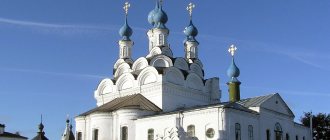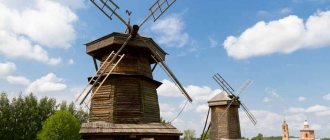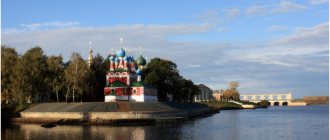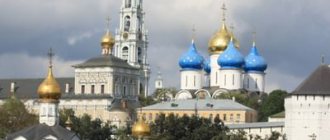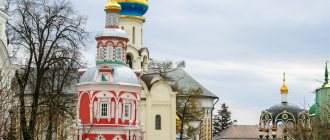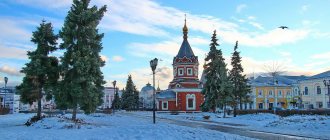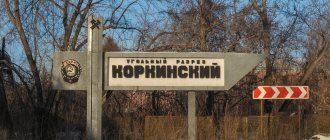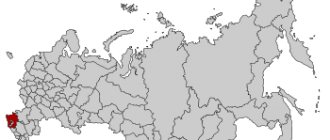Yaroslavl is one of the oldest and most revered Russian Volga cities. It has a very interesting history of formation, rooted in a distant, already semi-legendary past associated with the names of great Russian princes
.
The history of Yaroslavl is closely connected with Rostov
,
Moscow,
Nizhny Novgorod and other Russian cities. Thanks to its strategically convenient location, Yaroslavl developed quickly and constantly occupied a leading position in size, beauty and population.
Monument to the founder of the city on Epiphany Square
The leading role went to Yaroslavl during the Time of Troubles
, when he was simply carried into the arena of the liberation struggle against the Polish interventionists.
Yaroslavl
anti-Bolshevik
uprising of 1918
were a memorable page of the city . The city behaved heroically during the Great Patriotic War. And a native of Yaroslavl became the first female cosmonaut.
The city has preserved its glorious past in architectural monuments, in historical names, in the streets and squares of the ancient core, which was formed as two cities - Rubleny
and
Zemlyanoy
. Of course, they developed as a single whole, and their names are simply symbols of individual territories and periods of the formation of Yaroslavl.
Historical period of the Chopped City
Based on the first mention of Yaroslavl in Russian chronicles, this city is the oldest Christian
settlement from all
Volga
cities.
The Yaroslavl Kremlin or, as it was also called, the Chopped City
(built from felled beams) appeared as a fortified settlement at the junction of the Volga and Kotorosl rivers at the beginning of the
11th century
.
Model of the territory of the Chopped City (Yaroslavl Kremlin)
pagans lived here
, and the place was called
Bear's Corner
because of the habitat of these wild animals in the local forests.
The pagan people made a living by hunting, fishing, cattle breeding and robbing passing merchant ships. They worshiped their god Volos
.
During one of the ordinary robberies of a merchant ship, it was rescued by the soldiers of Yaroslav the Wise
, who, after a short battle and victory over the pagans, appreciated the convenient location
of Strelka
and decided to create an outpost fortress here to protect the approaches to Rostov.
Memorial Stone installed at the site of the founding of Yaroslavl
Conquering the local population and defeating the wild Bear
(as the legend says), Yaroslav the Wise builds a wooden-cut fortress, which receives his name, and in it the first Orthodox
church of Elijah the Prophet
.
After this, the lands begin to be populated by working people, who build housing, engage in crafts, give birth to children and, ultimately, create a new city - Yaroslavl. The role of all representatives who made a significant contribution to the creation of the city is mentioned in the sculptures of the Monument “1000 Years of Yaroslavl”
, installed in Strelka Park.
Prince, Warrior and Priest at the Monument “1000 Years of Yaroslavl”
Over time, princely chambers, houses of the nobility, economic and residential buildings grew on the territory of the Kremlin. The city reached particular prosperity during the reign of princes Konstantin Vsevolodovich
(early 13th century) and
Fyodor Cherny
(late 13th century).
Early 13th century
stone construction of churches (the Assumption Cathedral) begins and one of the first Russian monasteries appears - Spaso-Preobrazhensky and Peter and Paul monasteries. Their walls more than once helped the city residents to hold back the onslaught of the Golden Horde conquerors. Despite the courage of the defenders, the city was repeatedly burned, and Russian soldiers died in fierce battles. But Yaroslavl did not give up.
Ancient stone fortifications of the Spaso-Preobrazhensky Monastery
During this period, Yaroslavl was the capital of an independent principality, which contributed to its economic growth and territorial development. But although Yaroslavl Posad is also beginning to be actively built up, until the end of the 18th century
The administrative and Orthodox centers were located in the Rubleny city.
An ancient legend about a bear
The history of the coat of arms of the city of Yaroslavl is as follows. It depicts a bear. This owner of the forests is one of the main characters in the ancient legend of how this city came into being. The history of the city of Yaroslavl is closely connected with this animal. In the “Legend...” you can read that when, after establishing a tribute from the residents of Medvezhiy Corner, Yaroslav the Wise came again to these places from Rostov, the residents unleashed “fierce beasts and dogs” on him. But the prince defeated the beast. Local residents were afraid of the power of Yaroslav the Wise and fell on their faces before him. Children especially love to listen to this story when you tell them about how Yaroslavl came into being. A brief history of the city for children must include this legend.
As you know, many peoples who had a cult of the bear had a kind of taboo - a ban on naming its name. They always spoke about the bear as “old man”, “beast”, “master”. Echoes of this phenomenon are found here and there today, naturally, only in the form of folk traditions.
The first princes - Yaroslavl miracle workers
The first princely chambers and stone churches (Assumption and Spaso-Preobrazhensky Cathedrals) were built under the Rostov prince Konstantin Vsevolodovich
of Vsevolod the Big Nest
, known to us from the school curriculum .
Vsevolod, who had many children, divided the lands between his numerous heirs, and Konstantin, in addition to Rostov, got Yaroslavl, for the development of which he did a lot, very much ( early 13th century
).
Ancient Yaroslavl. Lithography
After the death of Konstantin, his son - Vsevolod Konstantinovich
, inherits the Yaroslavl lands, which under him become an independent appanage
Yaroslavl principality
.
Thus, Vsevolod in 1218
becomes
the first
Yaroslavl prince. He died in 1238 in another battle with the Mongol-Tatars, leaving behind two sons.
Vasily , would manage the principality for more than 10 years
, and after his death to Konstantin, the full namesake of his grandfather.
This next Konstantin Vsevolodovich
will die in the legendary battle with the Mongol-Tatars on Tugovaya Mountain
in 1257
. Both brothers found peace in the basement of the Assumption Cathedral in Rubleny Gorod.
The battle of Yaroslavl with the Mongol-Tatars on Tugovaya Mountain in 1257
The city and the entire principality reached unprecedented fantastic prosperity during the reign of the next Yaroslavl prince Fyodor Cherny.
(
late 13th century
), whose second wife was the daughter of the Khan of the Golden Horde, who converted to Orthodoxy. With her, he ruled the Yaroslavl principality, which during this period was not subject to devastating Mongol-Tatar raids, unlike their closest neighbors.
Fyodor Cherny provided protection for the principality from debilitating internal strife. His wife, baptized Anna, built Orthodox churches in the city, for which icons were painted. For example, the garrison Temple of the Archangel Michael
is the stone successor to the wooden church of the same name, built by Anna.
Stone Church of the Archangel Michael on the site of the former wooden one
Fyodor and Anna had two sons, David
and
Konstantin
.
Before his death, Fyodor himself became a monk and found peace in the Temple of the Entry of the Lord into Jerusalem,
attached to the Spassky Cathedral, and he was not buried in the ground, but simply covered with a veil. After the death of Feodor, David reigned for more than 20 years. Constantine never ruled the Yaroslavl principality, but legends say that he was distinguished by his kindness and humility.
After their death, both brothers were placed in the same way as their father in the crypt of the Spassky Cathedral, and also without burial. And this was at the beginning of the 14th century
. And then events developed very interestingly.
Temple of Yaroslavl Wonderworkers in the Spaso-Preobrazhensky Monastery
The last Yaroslavl prince who ruled in the mid- 15th century
,
Alexander Fedorovich
, voluntarily accepted the patronage of Moscow.
The Yaroslavl principality became part of the Moscow principality under Ivan the Third. This was in 1463
.
At the same time, Alexander Fedorovich raised the question of the burial of
Fyodor Cherny and his sons.
But when the coverings began to be removed from the deceased, inexplicable healings occurred. Fyodor and his sons were canonized and named Yaroslavl Wonderworkers
.
Fyodor Cherny with his sons - icon of the Yaroslavl Wonderworkers
the Temple of the Yaroslavl Wonderworkers was built especially for them
.
During the Soviet regime, their relics were displayed in the Elias Church for public viewing, and then they were kept in the Fedorov Cathedral Church
. Nowadays they are the shrine of the new Assumption Cathedral.
The sons of the first Yaroslavl ruler, Vasily and Konstantin Vsevolodovich,
.
In 1501,
the city was engulfed in another powerful fire, in the flames of which the city’s first stone churches, Spassky and Assumption, perished. So, while clearing away the rubble of the Assumption Cathedral, the relics of the second and third princes were found, who also turned out to be miraculous and were recognized as saints.
Images of Saints Basil and Constantine. Ancient embroidery
Thus, the first Yaroslavl princes, buried in the first city stone temple buildings, turned out to be miraculous during the discovery of their relics. This became an attractive moment for many believers who wanted to venerate such amazing Yaroslavl shrines
.
Formation and development of Zemlyanoy City
At the end of the 12th century,
as already mentioned
,
the Yaroslavl population begins to develop the land outside the border of the Rubennoy city - this is how
the settlement
.
The Posad territory in the 13th century
was quite densely populated by artisans and peasants.
All residential areas with churches and bazaars are fenced with an earthen embankment - ramparts. This is how Zemlyanoy City was created, which existed within these borders almost until the beginning of the 19th century
. Therefore, the entire history of the city of this period, the construction of various architectural objects, wars and fires are also the history of Zemlyanoy City.
Plan of Rublennoye and Zemlyanoy towns in the 17th century
In the middle of the 15th century
Yaroslavl is part of
the Moscow Principality
.
The city becomes more beautiful and stronger, and gradually turns into one of the largest cities of medieval Rus'. When in the 16th century
it became a major point
of trade
between Russia and the eastern countries and with the countries of Europe, the time of prosperity began - Yaroslavl in terms of population and the number of households in those days was inferior only to Moscow.
However, many buildings were destroyed at the beginning of the 17th century during the events of the Time of Troubles
.
But after the establishment of the Romanov monarchy, the city began to recover at a very rapid pace as a commercial and industrial city, and in terms of trade turnover it soon took third place
, after Moscow and Kazan. This contributed to the development of stone construction in the city.
Handsome Yaroslavl in the 17th century
Until the middle of the 17th century
The fencing of the settlement territory was purely earthen with periodically installed patrol gates and solid wooden towers.
But after the “Great Fire”
of 1658, which brought terrible devastation, stone towers were built - both blind and drive-through. The earthen ramparts around the Zemlyanoy City were also increased.
However, these structures turned out to be no longer relevant (the centralization of the country was over and no new attacks were expected), so over time, almost all the stone towers were dismantled for building materials. The Volzhskaya, miraculously preserved from those times, tell us about their appearance and medieval greatness.
and Vlasyevskaya tower.
“Vlasyevskaya (Znamenskaya) Tower today
The city grew and was surrounded by settlements
.
In the 17th century,
there was a massive construction of stone churches, many of which have survived to this day.
Yaroslavl temple builders developed their own style using polychrome tiles
and figured bricks. The city churches of that period are distinguished by rich decor, powerful five-domes and unique interior fresco painting.
The 17th century became “golden” for Yaroslavl stone church building. It was during that period that numerous township and settlement temples were built, which are today monuments
medieval ancient Russian architecture. (for more details see Temples of Yaroslavl)
Elijah Church in Zemlyanoy Gorod - 17th century
, the residence of the Metropolitan moved to Yaroslavl
from Rostov, for which a powerful architectural ensemble is being built.
Metropolitan Chambers
will tell us about it .
At the beginning of the 18th century
Yaroslavl ranks second after Moscow and becomes a large administrative unit.
The city gets its own Coat of Arms
.
Economic development is proceeding at a rapid pace, the first manufactories
(linen factories in 1722), numerous
crafts
- leather, candle making, brick making, etc.
Educational institutions appeared in the form of the Digital School
and the Theological Seminary, the first Russian
Theater
(now the F. Volkov Drama Theater).
Drama Theater named after F. Volkov
In the 70s 18th century
a widespread era of urban planning changes began, which, of course, affected Yaroslavl. By the beginning of the 19th century, Zemlyanoy City lost its borders and became part of a newly organized Yaroslavl.
Names of city streets
One cannot help but notice one fact when describing the city of Yaroslavl. Its history and sights are all very interesting. However, the names themselves associated with this place are no less curious. As you know, Yaroslavl is one of the most ancient cities of Rus' with a centuries-old history and natural features. But, looking at the map of the city today, we will not see many figurative, ancient names. The street names are as follows: Revolyutsionnaya, Sovetsky Lane, Deputatskaya, Pervomaiskaya, Kooperativnaya, Shkolnaya, etc. However, there are also names associated with the history of this city: Melnichny Lane, Gorodskoy Val, Nekrasova, Yamskaya, Suzdalskaya, Matrossky Spusk, etc.
Yaroslavl during the Time of Troubles
Interesting events in Yaroslavl are associated with the Time of Troubles. Few people know that the famous Maria Mniszech
- the wife
of False Dmitry the First
(G. Otrepyev) and the first proclaimed Russian queen (long before Catherine the First), after the death of her husband, was arrested by the new tsar -
V. Shuisky
.
Together with other family members, Mnishik, deprived of jewelry and rich clothes, was sent to a settlement
to Yaroslavl, where she lived for almost two years
from 1606 to 1608
.
about 400
were then taken into exile in Yaroslavl , and they were settled outside Zemlyanoy Gorod, in the area of present Sobinova Street, under the protection of archers.
Arrested Maria Mnishek in Yaroslavl. Artist Klodt
Then, Maria, eager for power, having promised to go back to Poland, did not fulfill her promise, but became the wife of False Dmitry II
(Tushinsky thief), recognizing him as her first saved husband, and fought for the Moscow throne for several more years. It all ended quite badly for her, but that’s a completely different story...
By the way, in November 1608
year Yaroslavl surrendered without a fight to the army of False Dmitry II, this most likely happened simply for the sake of preserving the city and its inhabitants from atrocities and violence. But soon the city will be at the epicenter of the liberation movement. It was then that the famous copy of the icon of the Kazan Mother of God came to the city, with which the subsequent creation of the Kazan convent was associated.
In April 1609
, after the battle near
the village of Grigorievskoye
and the flight of the Polish garrison, liberation detachments of
N. Vysheslavtsev’s
, organized in Vologda, entered Yaroslavl. This was one of the brightest episodes of the liberation struggle and the first serious victory of the Russians over the Poles.
After the battle with the Polish invaders. Painting
The Poles fled from Yaroslavl. And the militia, understanding the importance of the strategic position of the city, carried out a number of works to strengthen
defensive structures. The towers were restored, the earthen ramparts were equipped with forts (sharpened logs).
But the Poles soon returned and besieged
Yaroslavl, wanting to return it to their leadership.
The people of Yaroslavl defended themselves heroically, concentrating their main forces in the area of the Vlasevskaya Tower. However, in early May, the traitor opened the Semenovsky Gate
, which was located in the area of present-day
Red Square,
. The defenders of the city were forced to take refuge on the territory of the Kremlin (Chopped City), and partly outside the walls of the Spaso-Preobrazhensky Monastery.
Although Zemlyanoy Town found itself under Polish rule and was subject to robbery and violence, the Kremlin and the monastery held out for more than three weeks!
After which the Polish troops lifted the siege and left for Kostroma. Today we are reminded of these heroic times by the buildings of the Kazan Convent, erected in honor of that enduring Polish siege on the outskirts of Zemlyanoy Town (now Pervomaiskaya St., 19 A). And Yaroslavl gradually became the center of the liberation movement of the entire country.
People's militias in the early 17th century
Everyone knows that the People's Militia
led by Minin and Pozharsky began to take shape in Nizhny Novgorod, it was there that the population of other cities flocked, wanting to take part in the liberation campaign against the Polish intervention.
The liberation campaign consisted of several stages. Not everyone remembers that at first the militias arrived in Yaroslavl
, where the formation of detachments continued for another
4 months
, and from Yaroslavl the liberators headed towards Moscow.
The People's Militia troops in Yaroslavl were located mainly on the territory of the Transfiguration Monastery. the “Council of All the Earth” was finally formed.
- the new Russian government, which, in addition to Minin and Pozharsky, included the princes
Dolgoruky
, Kurakin,
Sheremetyev
, etc. This “Council” headed the leadership of the liberated Russian territory and the organization of the further liberation of the country.
Spaso-Preobrazhensky Monastery of the 19th century
Yaroslavl during this period became the unofficial capital
Russia.
From it, detachments were sent to liberate nearby cities, Prince Pozharsky and other authorized representatives conducted diplomatic negotiations
on providing assistance to the militias or simply on maintaining peaceful relations with
Sweden
,
Germany
, and the Novgorod state. As a result, Swedish and German artillery troops arrived to help the People's Militia.
Thus, the Yaroslavl “standing”
was very effective. The number of militia, its combat and organizational power increased significantly. Many cities began to restore law and order and economic activity in their territories, because militia troops provided them with various assistance, including in the fight against bandit formations that took advantage of the confusion in the country and embarked on the path of robbery.
In July 1612
detachments of the People's Militia left the Spaso-Preobrazhensky Monastery and set off to liberate
Moscow
.
This liberation was finally completed only on November 4
, after the capture of the Moscow Kremlin.
Today this day is celebrated as National Unity Day. And the Monomakh cap
on the Coat of Arms of Yaroslavl serves as a vivid reminder of the city’s role in the events of the Time of Troubles.
Town planning changes of the 18th century
During the reign of Catherine II
urban planning changes have affected all Russian cities, from small to large.
In the second half of the 18th century, Yaroslavl was subjected to a centralized radical redevelopment
, but its main architectural ensembles were preserved. The radial-ring planning of the city center began from Ilyinskaya Square (today Sovetskaya) and its beautiful Temple of Elijah the Prophet.
Sovetskaya Square with Elias Church today
The Empress was directly involved in the drawing up of the city plan before its approval. All the narrow and crooked streets spontaneously formed over several centuries in Zemlyanoy Town, according to the master plan
new buildings were transformed into smooth rays of streets diverging and converging in squares, gradually forming a network of the modern central part of the city.
Plan of Yaroslavl with modified street layout
It was the Yaroslavl example of Catherine’s urban planning policy that was identified by UNESCO
as the most outstanding, and
since 2005
the city center with its former Earthen Town is on the World Heritage List.
Under Catherine the Second, Yaroslavl became the center of governorship
and provinces.
A palace is being built for the governor on the main square (lost today). The buildings of the Public Offices
are also being built , completing the architectural ensemble of Ilyinskaya Square.
View of Soviet Square from above. with Office Buildings
The city is also being built up with brick houses, mainly in the classical style, dozens of industrial enterprises, a Noble Gymnasium, a Printing House, etc. are appearing.
Yaroslavl militias also actively participated in the Patriotic War of 1812
.
After the war, the city began to be decorated with promenade areas of boulevards
, built on the site of filled-in defensive ditches and leveled earthen ramparts, i.e.
along the current Pervomaiskaya Street
.
The Volzhskaya Embankment
began to be improved , on which the Governor's Palace and the Gazebo appeared.
And below there were piers for river shipping. The first university appeared in the city - the Demidov Legal Lyceum
.
Yaroslavl 19th century
At the end of the 19th century, under the mayor of the city I. Vakhromeev
Yaroslavl was equipped with
running water
,
electric lighting
, and telephone communications. Tram traffic began around the city.
By the beginning of the 20th century
The main formation of the historical appearance of the central part of the city ended.
Yaroslavl during this period was one of the most beautiful, largest and developed Russian cities. The presence of many styles of Russian architecture dating back to different centuries made Yaroslavl truly unique; it was even called the “Florence of the Russian North
.
Yaroslavl in the second half of the 19th century
Today, the territory of the former Rubleny and Zemlyanoy towns is the most historical and tourist-rich urban area. The most iconic squares
- these are Sovetskaya, Epiphany and Volkovskaya.
And the most popular walking routes run along the Volzhskaya
and
Kotoroslnaya
embankments,
Pervomaisky Boulevard
and the Strelka area.
Walking area of the Volzhskaya embankment
Background
Based on archaeological excavations, it can be argued that on the territory of modern Yaroslavl there was an ancient settlement dating back to the 1st millennium BC - the era of the beginning of the Iron Age. But there were earlier settlements at this place, which date back to the 3rd-5th centuries. The founding of the city of Yaroslavl dates back to the 10th-11th centuries; until this point, the Volga region was inhabited by Finno-Ugric peoples. The gradual resettlement of the Slavs to this territory begins in the 8th-9th centuries. At the same time, many archaeologists emphasize that colonization took place without violence. The Slavs coexisted peacefully with the Merya people, and for some time the tribes practically united. In the year of Yaroslavl's founding, the banks of the Volga were quite densely populated; there is information about several villages whose residents were engaged in fishing and crafts.
Yaroslavl Soviet
The very first event of the new Soviet era was the Yaroslavl anti-Bolshevik
the July
uprising of 1918
, the brutal suppression of which marked the beginning of the Red Terror in the city.
In addition, many civilians died under the shelling of the Red artillery, some of them fled from the city. Many buildings were also destroyed. The number of Yaroslavl residents after the suppression of the uprising and repressions decreased by almost half
! Temples were closed and destroyed, church valuables were confiscated. Fortunately, the militant atheists were not able to destroy everything.
The building of the Theological Academy after the suppression of the Yaroslavl uprising of 1918
In the late 20s and early 30s, life in the city began to improve. New houses were built, a new urban plan was approved, and new industrial enterprises appeared. During the Great Patriotic War
the city worked for the needs of the front, many Yaroslavl residents were on the line of fire.
After the war, construction and development of the city continued, which practically did not affect the historical center. It is the preservation of many historical and architectural monuments of the 17th-19th centuries
and the integrity of the historical development of the center, made it possible to add Yaroslavl to the list of the tourist Golden Ring of Russia that was formed in the 70s.
Memorial sign - Yaroslavl - the capital of the Golden Ring
To Yaroslavl's celebration of its 1000th anniversary ( 2010)
) many architectural objects were restored and new memorial signs were installed, including
the Monument “1000 Years of Yaroslavl”
.
Monument “1000 years of Yaroslavl” in Strelka Park
Volzhskaya embankment
This is probably the most beautiful embankment of the famous embankments of the river. Volga. IN 1823
last year it underwent reconstruction - the coastline was strengthened, gazebos were installed and new trees were planted. Now only one of the gazebos has survived. On Strelka, where the r. Kotorosl flows into the Volga, you can feel free breathing and wind blowing. The impression of what he saw is breathtaking.
Coat of arms of Yaroslavl
Bear Image
as the main figure of the Yaroslavl coat of arms appeared during the reign of
Alexei Mikhailovich
, i.e.
in the 70s
17th century . The bear is, on the one hand, a symbol of strength, on the other hand, it is a connection with the legend of Yaroslav the Wise’s victory over it. It was with this victory that the development of the Volga-Korotel banks began. But subsequently the color and pose of the bear changed in the image of the Coat of Arms.
Cue ball of Yaroslav the Wise with the Bear on the site of the future city
In the official approval of the coat of arms in 1730
it was written that the Bear should be
black
, the main field
yellow
, his battle ax -
the chase
- should be
red
. Based on this statement, city seals were minted.
When did Yaroslavl become a provincial center under Catherine II
, the type of coat of arms was officially changed, because it became not just a city coat of arms, but
a provincial one
!
The overall shield background with the lower point should have been silver
, and the Bear walking to the right carried a
gold-colored
. Although many seals remained with the previous coat of arms.
Coat of arms of Yaroslavl 1778
Subsequently, another version of the city coat of arms is developed ( 1856
.), but it has not received official approval.
In this version, an addition appeared above the shield in the form of an Imperial crown
, and outside there was decor from gilded oak branches and St. Andrew's ribbon.
Coat of arms of 1856
In Soviet times, images of coats of arms were not used. But the Yaroslavl Automobile Plant used the figure of this beast for its emblem. And the image of the coat of arms itself appeared on the emblems of the celebration of the 950th anniversary of the city.
The 90s were marked by the beginning of the revival of Russian traditions, and in 1993
on this wave, the Yaroslavl Council of People's Deputies approves the next Coat of Arms of Yaroslavl. The shield remained silver, and the Bear is now brown, but with the same ax for some reason he went in the opposite direction. The shield itself was framed with oak branches and Russian tricolor ribbons.
Coat of arms 1993
And finally, the last change to the Yaroslavl Coat of Arms occurred in the summer of 1995
year. This image was close to the plot of the 18th century. Having made the Bear black again, it was turned to the right again. The silver coat of arms was crowned with the Monomakh cap.
Coat of arms 1995
Today, bear figures adorn the emblems of many Yaroslavl organizations. It is used by the Lokomotiv Hockey Club
and
the Shinnik Football Club
, Distillery and
Yaroslavl Beer Factories
.
Figures of Bears are found everywhere in Yaroslavl
And at the Yaroslavl Museum-Reserve
, based in the Spaso-Preobrazhensky Monastery, has its own coat of arms mascot in a living form -
the Bear Masha
, which almost all tourists visiting the museum want to see.
Masha the Bear - the mascot of the Yaroslavl Museum-Reserve
And in the private collection of the Museum “My beloved Bear”
you can see dozens of stuffed, plastic, wooden and other toy bears collected over the years.
Bears can also be found in the form of landscape sculptures
on city streets and park alleys, in
the form of flower beds
, etc.
In the Park of the 1000th Anniversary of Yaroslavl there is a sculpture by Z. Tsereteli
-
Bear with Fish
, and the wild beast is made in life size.
Sculpture by Z. Tsereteli “Bear with Fish”
Author of the article: Kasatkina Tatyana
Climate
The climate of the city of Yaroslavl is moderate - continental, formed under the influence of the Atlantic Ocean. 150 days a year with temperatures below zero. 590 mm of precipitation falls per year. Most of them fall during the warm period. Winter in Yaroslavl is moderately cold and moderately snowy. It lasts for more than five months. The average January temperature is −11 °C, rarely dropping below 30 °C. There are thaws in winter. The average height of snow cover is 35 – 50 cm, sometimes up to 70 cm. Snow cover appears in the second half of November and persists for 140 days. Winds predominate from southern and western directions. The average wind speed is 4.2 m/s, sometimes more than 8 m/s. Summers are moderately warm and humid. The average July temperature is +18 °C, sometimes up to +37 °C
